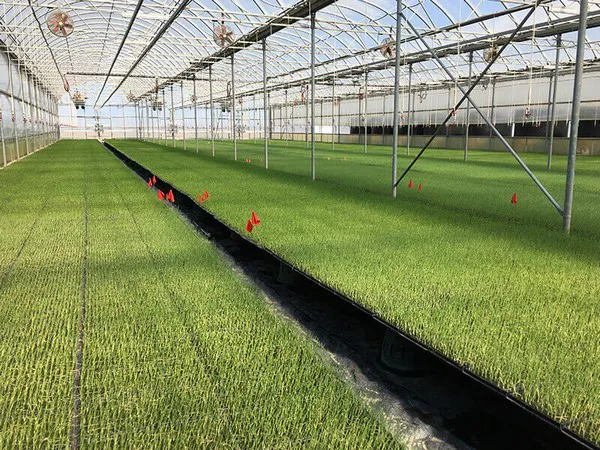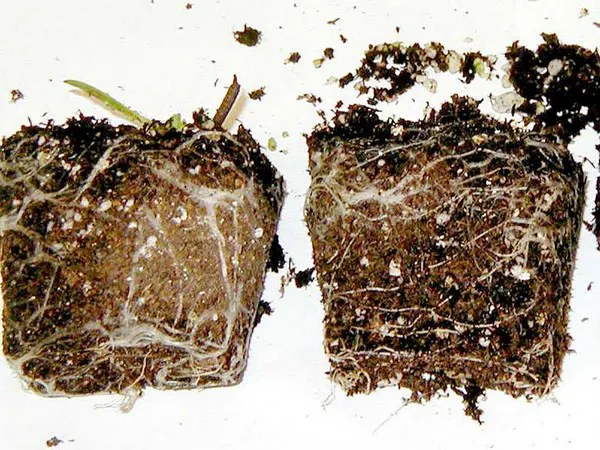Water holding capacity is greatly influenced by the size of the growing medium particles. Coarse particles create macropores which account for drainage and air porosity, while fine particles create micropores which retain water. A mixture of coarse and fine particles can be prejudicial for a substrate because the macropores will be filled by the fine particles, which reduces the air porosity of the growing medium.
Water holding characteristics of seed germination substrates
A substrate with fine components is mainly used as a seed germination medium, and depending on the grower’s preferences, it can also be used to root cuttings. Therefore, this type of substrate is designed to easily fill small cells and to hold lots of water. Depending on the season of the year and the grower’s preference, a seed germination substrate may contain perlite or vermiculite.
Usually, a germination substrate with perlite, such as PRO-MIX FPX, is more widely used during winter due to its lower water retention capacity, whereas a germination substrate with vermiculite, such as PRO-MIX PGX, is used during the summer since it has a higher water retention capacity. However, both mixes are designed to hold sufficient water and provide good aeration between watering cycles when used properly.

Water holding characteristics of potting substrates
Substrates with coarse components were developed for larger containers such as pots and baskets. The ratio of peat moss, with respect to components like perlite, vermiculite, coir, etc., is going to differentiate the water holding characteristics of different substrates. For example, PRO-MIX BX has a high water holding capacity with an air porosity between 12-17%, while PRO-MIX HP has a slightly lower water holding capacity and higher air porosity of 14-20%. The main difference between them is the amount of perlite: PRO-MIX BX has a little vermiculite and almost half perlite compared to PRO-MIX HP.
Proper bale processing
Preserving the water holding characteristics and physical properties of a substrate starts with proper handling and processing of the substrate. For example, the proper way to loosen 3.8 cu. ft. bales of PRO-MIX HP MYCORRHIZAE + BIOFUNGICIDE with a bale breaker that can handle five bales at a time is to place five bales in the machine, run the machine at slow speed and add enough water to obtain the proper moisture content.
The substrate should be slightly damp to the touch and you should be able to form a ball in your hand when you squeeze the substrate. However, you should not be able to squeeze water from a sample. It is best to run the bale breaker for only three minutes and then empty the machine before putting in new bales. This results in containers being filled with uniformly decompressed substrate with minimal damage to its structure.
Compressed bales of peat moss or substrate are added to a bale breaker (or fluffer), many of which have ribbon blenders as seen in this picture. Run the breaker long enough to uniformly break up compressed substrate and then empty the machine quickly to avoid damage to the substrate structure.
Consequences of improper bale processing
Now, with the same bale breaker, let’s take five bales of 3.8 cu. ft. of PRO-MIX HP Mycorrhizae + Biofungicide with the desirable amount of moisture. Some batches of substrate are processed for 10 minutes at high speed and the breaker continues to run for an extra five minutes before it is emptied. A couple of weeks after planting, containers may dry out at different rates and have uneven growth, but there is a pattern: it occurs every 3,000 pots. If the machine held five bales to fill 3,000 pots, this can be a situation where the substrate spent too much time fluffing and the bale breaker was operating at high speed.
This demonstrates that the growing medium was fluffed too long, causing physical damage to the peat fibers and perlite, which created a lot of fine particles. Fine substrate particles slightly increase water holding capacity but greatly decrease air porosity, creating a poor environment for root development and slow overall plant growth. Therefore, these plants use little water due to slow growth, and the substrate dries out slowly and easily becomes waterlogged.
Substrate age influences water holding capacity
The age of the substrate can influence its water holding capacity. Peat moss and other organic materials have surface waxes that are hydrophobic. Because of this, a wetting agent is added to substrates to promote uniform water absorption. The problem is that over time, the wetting agent is broken down by natural biological organisms that come with the substrate.
For optimal results, is it best to use peat-lite substrates within 9-12 months after manufacturing, bark substrates within 5-6 months, and organic peat-lite substrates within 2-4 months. The degradation of the wetting agent will also depend on the temperature as high temperature tends to increase natural microbial activity and therefore accelerates degradation of the wetting agent.
 These plants were grown in an old substrate with little to no wetting agent remaining. Notice that most of the root ball is dry right after watering. A wetting agent application would reinstate uniform wetting of the root ball and increase water holding capacity. Source: Premier Tech
These plants were grown in an old substrate with little to no wetting agent remaining. Notice that most of the root ball is dry right after watering. A wetting agent application would reinstate uniform wetting of the root ball and increase water holding capacity. Source: Premier Tech
An aged substrate with little to no remaining wetting agent is going hydrophobic and is characterized as having a low water holding capacity due to uneven water distribution throughout the container. Consequently, crop growth is going to be uneven due to the uneven water and fertilizer retention from one pot to another. The solution is to apply a wetting agent which will allow for uniform rewetting of the dry areas.
In conclusion, it is very important to match the substrate’s water holding capacity and texture to the crops' needs. When loosening bales in fluffing machines, add the appropriate amount of water and minimize the amount of time and speed the machine operates, in order to minimize damage to the substrate. In addition, it is important to use substrates within the recommended time and store the bales in a shaded area to avoid direct sunlight and high temperatures, which accelerate the breakdown of the wetting agent.
For more information: Premier Tech
Premier Tech
www.premiertech.com
